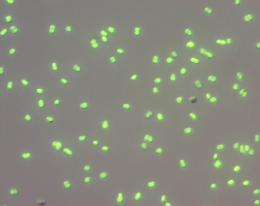Research reveals key to world's toughest organism

(PhysOrg.com) -- A new study by Cornell researchers uncovers the details of how the world's toughest bacterium survives lethal radiation exposure.
Listed in the Guinness Book of World Records as "the world's toughest bacterium," Deinococcus radiodurans can withstand extreme temperatures and drought conditions, lack of nutrients and a thousand times more radiation than a human being.
A new study by Cornell researchers reveals that nitric oxide -- a gas molecule used in many metabolic processes in animals and a pollutant in the atmosphere that leads to smog -- plays a key role in D. radiodurans' recovery when exposed to ultraviolet radiation (UV).
The study, appearing online Oct. 19 in the Proceedings of the National Academy of Sciences, may have implications for why and how nitric oxides act as signals in mammals for cell-to-cell communication, dilation of the vascular system and activating the immune system; in bacterial responses to antibiotic treatments; and in food safety efforts as D. radiodurans appears in some canned foods. The organism is also studied for use in environmental cleanup of sites contaminated with radiation and toxic chemicals.
Brian Crane, a Cornell associate professor of chemistry and chemical biology, and colleagues, discovered a gene in D. radiodurans that, when exposed to UV radiation, increases production of an enzyme responsible for creating nitric oxide. They then engineered bacteria without this gene. When zapped by radiation, the engineered bacteria repaired themselves but failed to grow and proliferate.
"Bacteria are much more sensitive to radiation damage when nitric oxide is not there," said Crane, the paper's senior author. Bhumit Patel, a graduate student in Crane's lab, is the paper's first author. "If you block the nitric oxide signal, the cell will repair but [will] not divide," Crane added.
In addition, the researchers were surprised to find that removing nitric oxide increased sensitivity to radiation but had no effect on the bacteria's ability to withstand other stressors, including exposure to oxidative damage that leads to toxic free radicals.
They also found that under normal circumstances there is a time lag in the process, where radiation exposure induces the cell to repair itself, but it takes a few hours for these bacteria to produce nitric oxide, which then activates a gene involved in cell proliferation and stress responses. "Nitric oxide seems to coordinate this growth response, but it's curious that the bacteria will wait to grow until they have repaired themselves," said Crane. "We don't know why it works this way, but there are analogies in human cells [for other processes]. There may be related pathways for controlling cell growth in animal cells."
Provided by Cornell University (news : web)















